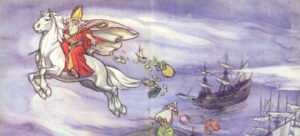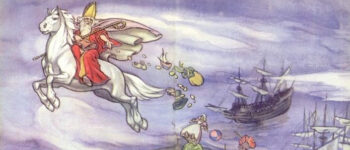1642: New Zealand’s First Christmas
December 20, 2024
By AHNZ

On the night before Christmas, 1642, the danger of losing it troubled more than a few. The Twelve Days of Christmas were due to begin, but in Protestant nations the future looked thin. Now Scotland, now England, now German and Swiss! The Christmas tradition faced the abyss!
The Wokesters of their day, the Puritans, the Protestants, were cancelling the ancient Christmas festivals, carnivals, carol-singing and other profane pastimes. Merrie England was out, the Puritan Awakening was in force. As early as 1640 the most un-merry and anguished Scottish Parliament made celebrating ‘Yule vacations’ illegal. In England Oliver Cromwell’s Puritanical Protectorate was fast catching up, fighting a Civil War to get their way and not stopping short of decapitating the Christmas-loving King Charles. In the American Colonies they were well advanced in such Puritanism, of course, and disgust with “pagan” joy was why they emigrated in the first place.
New Zealand in 1642, then, was very fortunate to have a happy Christmas. Christmas for Nieuw Zeeland, as it was then, was in the hands of Abel Tasman’s little fleet of ships (Heemskerck and Zeehaen.) This ensured that Sinterklass (Santa Claus) would be present in the Marlborough Sounds that year.
Unlike much of the rest of the Western world, the Dutch Golden Age did not lean heavily on enforcing anti-Christmas rules on its people. Still less so in their colonies such as in America (New Amsterdam) and the East Indies (Batavia.) Tasman and his men were even more extended and did not have to conform to what some Santa-hating religio-bureaucrat was Virtue Signalling back home.
“In the early 1640s, as power passed from Charles I (who largely supported the existing rituals and festivals) to the Long Parliament, parliament began the process of clamping down on the celebration of Christmas…Parliament, in fact, met and worked as usual on 25 December 1643…stressed that 25 December was strictly to be kept as a time of fasting and humiliation, for remembering the sins of those who in the past had turned the day into a feast, sinfully and wrongfully ‘giving liberty to carnal and sensual delights’.” – The Cromwell Association
“New Amsterdam, New York’s precursor, was a company town. While laws suppressing the celebration of Christmas were on the books until 1681 up in Massachusetts and other places, down in New Amsterdam, rudimentary holiday traditions were openly, even casually, celebrated… The settlers of Dutch New Netherland could theoretically celebrate how they wished. ..Sinterklaas, a Dutch gift-giving tradition where children sat their shoes outside their homes to be filled by a visiting St. Nicolas…Amsterdamers didn’t stop at Christmas; the party kept going for weeks afterwards, throwing Manhattan’s very first New Year’s parties. According to one source, “On Nieuw Jaar (New Year) and Kerstydt (Christmas) the Governor’s house was ablaze with candles and the young men and maidens danced in the ‘entry’.” – The Bowery Boys (2021)
“The newly independent Dutch Republic officially became a Protestant country and abolished public Catholic celebrations. Nevertheless, the Saint Nicholas feast never completely disappeared in the Netherlands. In Amsterdam, where the public Saint Nicholas festivities were very popular, main events like street markets and fairs were kept alive with persons impersonating Nicholas dressed in red clothes instead of a bishop’s tabard and mitre. The Dutch government eventually tolerated private family celebrations of Saint Nicholas’ Day, as can be seen on Jan Steen’s painting The Feast of Saint Nicholas.” – Wiki
“After Tasman’s vessels left the scene of the terrible massacre of the ship’s crew members, they sailed east and anchored in a large bay at the northwestern entrance of Pelorus Sound, now known as Admiralty Bay. Here, for the first time in the history of New Zealand, Christmas Day was celebrated. Robert McNabb, a New Zealand historian, discovered during his historical research in Europe many years ago the log of one of Tasman’s sailors in the Belgium Museum. The sailor had recorded their fine Christmas dinner, the chief dish of which was roast pig (an animal brought aboard Tasman’s vessels).” – Nelson Evening Mail (1937,) Papers Past
Morning in Murderers’ Bay, Blood drifted away.
It was something different, something Nobody counted on.
– The Unhistoric Verse, Allen Curnow
 Tasman’s people had, after all, need of some Christmas joy. On 19 December they had been attacked, 3 crewmen killed, by Maoris at Moordenaers Baij (Murderer’s Bay, now Golden Bay.) One body was taking ashore and, most probably, eaten as an act of Contact Magic to absorb the attributes of the slaughtered man. Historian James Belich apparently quipped that this was probably the first of many European products consumed in New Zealand!¹
Tasman’s people had, after all, need of some Christmas joy. On 19 December they had been attacked, 3 crewmen killed, by Maoris at Moordenaers Baij (Murderer’s Bay, now Golden Bay.) One body was taking ashore and, most probably, eaten as an act of Contact Magic to absorb the attributes of the slaughtered man. Historian James Belich apparently quipped that this was probably the first of many European products consumed in New Zealand!¹
The Dutchmen licked their wounds, weathering a stormy Christmas. 5 Days spent at Admiralty Bay. Officially they never landed but I can’t get behind that. As Don Jacobs pointed out to AHNZ, they were 66 days out from Batavia so prone to scurvy. If Tasman did not make landings he and all his crew would have died before making it back to base.
Furthermore, Robin Ford wrote to AHNZ saying he lives in Golden Bay by a beach called Pohara. Tasman is said to have called in the bay to collect water from the Motupipi stream which ran through Pohara and the interesting part is his map shows that very stream. This suggests very strongly that the expedition did spend time on New Zealand soil after all. Ref. ibid
No puritans, the crew drank wine although Tasman didn’t put Christmas in his journal. Perhaps the officials back home were not safe to report these facts to in a time of Puritanism? But historian Robert McNab discovered the journal of one of the crewmen in the Belgium Museum that is more descriptive: “Our sailor friend also tells us that, on the twenty-fifth [December,] the master of the Zeehaen, and the merchant, came on board the Heemskerck as guests of the commander, two pigs were killed for the crew, and a tankard of wine given to every mess “‘as it was the time of the fair” —the first Christmas celebrations on the coast of New Zealand.” Ref. A History of Northern New Zealand from 1642 to 1818, Robert McNab (1914)
It was also part of the 1642 Christmas in Nieuw Zeeland to name the Drie Koningen Eyland (Three Kings Islands) Three Kings Islands. On the 5th and 6th January the expedition found these islands at the time of Twelfth Night. The day the 3 Wise Men (Kings) visited Baby Jesus. Having done this, it was time to head back home to Batavia.
It’s pleasing that Tasman’s expedition was able to leave New Zealand a lasting Christmas gift in a discovery and name that has lasted.
—
1 The News (2017,) First Encounter 375, Facebook (2017)
Image ref. Santa Claus Comes to America, Caroline Singer and Cyrus Leroy Baldridge (1942,) AHNZ mod (2024)
Ref. The Feast of Saint Nicholas, Jan Steen (c. 1665–1668) shows the Dutch as celebrating Christmas for children much as we do today
Ref. 1770: Christmas in Batavia, AHNZ
 Like Comment Share
Like Comment Share





